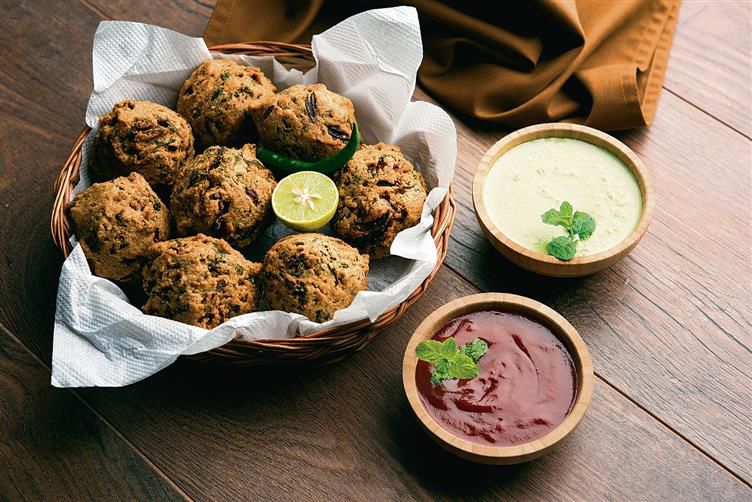Art of frying pakoras
Pushpesh Pant
When rain-bearing clouds gather during the monsoon, the lovelorn start pining for the beloved, separated by circumstances. This is the theme of ‘Meghdoot’, the lyrical poem penned by the great Sanskrit poet Kalidasa. Jayadeva, who composed the masterpiece ‘Gita Govinda’, was inspired by the same theme. But then, as everyone knows, we don’t live by love alone. There are other yearnings and desires stirred by hunger.
Many remain unmoved by evocative paintings, poetry or musical modes celebrating the rainy season, but mention any deep-fried stuff paired with pleasantly pungent chutneys and their mouth fills up with water. In the Indian subcontinent, there is no dearth of pakoras, mini-badas, bondas that tempt one to savour regional flavours. In Bengal, it is bhaja of eggplant, potato or assorted cutlets. In Uttar Pradesh, freshly fried mangodies are popular, as in the rest of Purvanchal.
Our regret is that nowadays, when you ask for a plate of pakora mix, what reaches the table is depressingly predictable — a few thick slices of besan-dipped and fried potatoes, some onion rings, a large floret of gobhi, one or two green chillies and a few batons of paneer. Everything is coated in a thick batter with more than a pinch of soda bicarb and still oozing oil when the order reaches you. A bottle of mass-produced sauce, not necessarily tomato, is plonked on the table. The sprinkling of pre-packed chaat masala is dominated by citric and tartaric acid and one almost regrets ordering the stuff.
There is yet another blight that marks the pakoras prepared in commercial outlets. These are fried in large batches and kept ready, half-done. These are then refried when ordered and one is told this is essential to make them really crispy and crunchy. We, however, recall those days when pakoras were prepared at home without any refrying and still turned out to be crisp and flavourful, with not a drop of oil staining the fingers. It goes without saying that the accompanying hari chutney was usually freshly ground with coriander, mint, green chillies and lime juice.
We see no reason why the art of frying pakoras at home should be allowed to die. Too many people have frightened themselves with scary stories about choked arteries and toxic transfats. If you prepare these fritters in small quantities, just enough for the family members for tea-time snacks when it is pouring, very little oil is required and there will be little left for reusing. Pakoras, we feel, should be shrunk to Lilliputian size. Flash frying the stuff on high flame will ensure that these don’t soak up too much grease.
Good friend and foodie Sangeeta Khanna has compiled a wonderful collection of pakora recipes in a mouth-watering book. If you can lay hands on a copy, many more ideas will start sparkling in your brain.
Vegetable fritters
Ingredients
Bread slices 2
Button mushrooms (medium-sized) 10-12
Tomatoes (small) 2
Onion (small, peeled) 1
Sweetcorn kernels 1/4 cup
Cashew nuts 6-8
Cabbage (grated) 1/4 cup
Carrots (grated) 1/4 cup
Potato (medium-sized) 1
Besan 2 tsp
Rice flour 2 tsp
Red chilli powder 1/2 tsp
Salt To taste
Oil 1/2 cup
Method
Cut bread slices into eight or more pieces in small squares. Wipe clean the mushrooms and chop into small pieces. Peel the potato and cut into small dices, do the same with onions. Cut the tomatoes in half and remove the eyelets. Pack tomatoes with corn kernels and cashew nuts. Keep aside. Prepare a batter after sifting the besan, rice flour, and adding salt and chilli powder, chopped onions, mushrooms and potatoes, grated carrots and cabbage, along with the bread squares. Mix well and shape into small balls pressing between palms. Reserve some batter to seal or cap the stuffed tomatoes. Heat oil in a pan over high flame and fry these pakoras.
Fry in batches as frying everything at once will reduce the temperature of the hot oil. Remove with slotted spoon and place on kitchen towels.
Fry the tomato pakoras separately. Enjoy with freshly ground green chutney.









